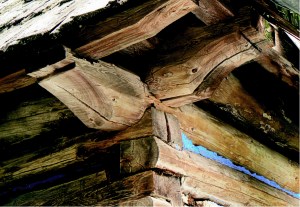Ľuba Paučulová
Traditional carpentry (from Latin faber tignarius) is one the oldest construction crafts and crafts in history. Manual processing of wood and connecting wooden elements by special hand-made joints are typical features of traditional carpentry. Contemporary carpentry differs from historic carpentry in the use of machine-processed wood and joining by metal joints.
A carpenter used to process raw wood with an axe. Mechanical water-wheeled saws were used from the 16th century, steam-driven saws from the 19th century. However, hand technique was used to process roundwood into timber until the early 20th century.
Carpentry including its traditional version almost disappeared around the mid 20th century. Wood for basic constructions (walls, ceilings and roof frames) diminished to be replaced by other materials. Massive industrial construction displaced carpenters to work as construction auxiliaries. Flat roof family houses were very popular.
Now, carpentry seems to be reviving. However, modern carpenters use glued and nailed constructions joined by special metal parts. Manual work has almost disappeared from modern carpentry and traditional carpentry continuity has almost been interrupted.
Do we have sufficient or insufficient conditions to maintain traditional carpentry in Slovakia?
It is a must to enhance archiving, protection and promotion in the field of protection of historical carpentry works. Architects and other experts suffer from lack of educational materials and trainings. New constructions in Slovakia do not maintain bonds with traditional regional architecture. Construction industry may facilitate preserving values of traditional carpentry.
